1. Introduction
Citrus fruits of Rutaceae family (Chung et al., 2000) are the most widely cultivated fruit crop in terms of area and production value (Ladaniya, 2008). Different species of citrus including oranges, lemon, grapefruit and mandarin, have unique flavor due to presence of various biochemical constituents (Poret et al., 2016). Citrus fruits are widely consumed worldwide and in South Korea because of their unique flavors and sour taste. Mandarin oranges, with robust cold tolerance, are mainly produced in South Korea (Jeong et al., 2004).
High fresh fruit consumption worldwide has significantly increased the export of citrus fruits. However, postharvest quality maintenance of citrus fruits, like other fruits, is challenging to current research, as long-term storage results in moisture loss and decay due to mold contaminations (Kassim et al., 2020). Various preservation techniques, such as heat treatment, fumigation, ultraviolet ray irradiation, and chemical treatment for biological decontamination have been employed to solve the contamination issue. The various side effects of these techniques, such as changes in fruit composition, structural changes due to high heat treatment, residues of toxic substances, and microbial resistance, necessitate the development of alternative decontamination technologies (Fields and White, 2002). Therefore, the efficacy of radiation energies, such as gamma rays, e-beams, and X-rays, is recognized as one of the best possible alternative technologies (Ko et al., 2012).
Food irradiation, certified by various international certification organizations, such as WHO, FAO, and IAEA, has been declared a beneficial and safe technique for sterilizing food and other public health products (Byun and Yook, 2003). Therefore, there is a need to clearly distinguish between nonirradiated and irradiated foods. Detection methods are classified into three categories based on physical, chemical, and microbiological changes occurring after irradiation (McMurray et al., 1996). The methods currently available, documented in both the Codex and European standards, include the DNA comet assay, photostimulated luminescence (PSL), and DEFT/APC, are used for screening, whereas thermoluminescence (TL) and electron spin resonance (ESR) are employed as verification methods for irradiated food (CAC, 2003). However, limitations in detecting ESR radicals from irradiated fruits necessitate the selective extraction of cellulose radicals through various pretreatments like, drying or extractions, to reduce the moisture content of the samples (Ahn et al., 2014; Delincée and Soika, 2002).
The significance of world trade in the economy of a country requires a safe phytosanitary alternative to chemical fumigants, such as methyl bromide, for the quarantine of fresh commodities (Lee, 2009), and reliable identification methods for irradiated foods and foodstuffs for both trading countries (Sanyal et al., 2019).
The Food and Drug Administration has allowed irradiation of fresh fruits and vegetables at doses of up to 1 kGy (FDA, 2007) as a phytosanitary measure. The USDA APHIS also authorized the import of fresh pomegranates into the U.S. mainland from India with a minimum irradiation dose of 0.4 kGy as a quarantine disinfection treatment. The recommended irradiation dose and standard postharvest processes will help effectively neutralize insect pests and mitigate the risks of their dissemination (USDA, 2012).
Thus, this study aimed to investigate different analytical methods, such as the electronic tongue (e-tongue) and PSL for screening, and ESR techniques, with improved methods of cellulose extraction through various drying pretreatments, for detecting the electron beam-irradiated mandarin oranges as a phytosanitary measure at 0, 0.4 and 1 kGy during post-irradiation storage for 15 days at 4°C.
2. Materials and methods
Fresh mandarin oranges were bought from a local fruit market in Daegu, South Korea. Mandarin oranges from ten boxes were sorted by color, size, and firmness. According to the irradiation dose, mandarin oranges were packaged in polyethylene (P.E.) packets and classified into three groups (more than 50 fruits per group).
The samples were treated with e-beam irradiation using an electron accelerator (ELV-4, acceleration voltage of 5 MeV, EB-Tech Co., Daejeon, Korea) to supply radiation doses of 0, 0.4 and 1 kGy at dose rates of 1.11 and 3.14 kGy/sec, respectively. After irradiation, the samples were stored at 4°C for 15 days.
The juice of irradiated mandarin oranges was evaluated using the ASTREE electronic tongue system (Alpha M.O.S., Toulouse, France). This system consisting of seven electrochemical sensors (SRS, GPS, STS, UMS, SPS, BRS, and SWS), was compared with a reference electrode (Ag/AgCl). Among all the attributes, taste attributes (SRS: sourness, astringency, bitterness; GPS: sourness, saltiness, metallic; STS: saltiness, spiciness, metallic; UMS: umami, saltiness, astringency; SPS: metallic, spiciness, umami; BRS: bitterness, astringency; SWS: sweetness, sourness) mainly affected the sensor. All the samples (120 mL each sample size) were analyzed for a duration of 120 sec, followed by washing the sensors (sample holders) with distilled water to control cross-contamination among samples. Five different fruits were sampled for five measurements, and principal component analysis (PCA) was employed to obtain the results. Comparison of similarities and dissimilarities in the e-tongue dataset was performed for sample grouping with various patterns.
A SURRC PPSL-irradiated food screening system (serial number 0021, Scottish Universities Research and Reactor Center, Glasgow, UK) was employed to measure the PSL photon counts registered in 60 sec. Mandarin oranges were carefully peeled, chopped, and placed in petri dishes of 50 mm diameter (Bibby sterilin type 122, Glasgow, UK). Subdued light conditions as per the protocol documented in EN 13751 (2002) and MFDS (2013) were used to measure the PSL photon counts (PCs). The PSL signals emitted from the sample were spontaneously recorded and displayed as PCs/min. The PCs were classified as “positive” [more than 5,000 counts (60 sec)], “intermediate” [between 700 and 5,000 counts (60 sec)], and “negative” [less than 700 counts (60 sec)] according to MFDS (2013). The samples were re-irradiated with 1 kGy dose of e-beam, followed by the first PSL investigations. The ratio of the second (PSL2) to the first (PSL1) measurements (PSL ratio, PSL2/PSL1) of PCs was calculated. The measured samples with a PSL ratio less than 10 were considered irradiated, whereas those with a ratio greater than 10 were considered nonirradiated ones.
According to the Korean Food Standards Codex, the freeze drying method is recommended for ESR measurements of irradiated food. In our study, the ESR spectra of orange peel were compared for different drying pretreatments: vacuum drying (VD), freeze drying (FD), and ethanol extraction & vacuum drying (EVD). The peel portion of the mandarin oranges was cut into small pieces and dried under each drying condition.
Samples were placed in a deep freezer (-35°C) for 24 h and dried for 48 h in a freeze dryer (model MCFD8518, ilShinBioBase, Gyeonggi, Korea) according to the method of Yordanov et al. (2006).
The samples were dried for 7-8 h in a vacuum drying oven (model LVO-2040, Lab Tech Co., Daejeon, Korea) to remove moisture.
A mixture of the sample (20 g) in 100 mL of ethyl alcohol (94%) was extracted for 10 min using an ultrasonicator (model POWERSONIC 420, Hwashin Tech Co., Seoul, Korea) and firmly squeezed to the maximum extent to remove ethyl alcohol, followed by drying in a 50°C vacuum drying oven for 5-6 h.
After drying, the samples were ground to a fine powder and 0.1 g powder from each dried sample was placed in a quartz ESR tube (5 mm diameter). Parafilm was used to close the open end of the sample tube. The detection of radicals in cellulose-containing food was evaluated using EN 1787 (2000) method. The X-band ESR spectrometer (JES-TE 300, Jeol Co., Tokyo, Japan) was operated at ambient temperature under the following experimental parameters: power, 1 mW; sweep time 30 sec; sweep width, 1×10 mT; modulation width, 0.7×1 mT; amplitude, 7×100. All measurements were performed in triplicate to improve the signal-to-noise ratio.
The experiments were performed at least in triplicate and the obtained data were statistically analyzed using the Statistical Analysis System (SAS) software (version 8.1, SAS Institute, Cary, NC, USA). One-way analysis of variance (ANOVA) was used to assess the differences between the means of the variables, and the results are presented as mean± standard deviation. Duncan’s multiple range test (p<0.05) was used to determine significant differences (SAS Institute, 2001).
3. Results and discussion
Storage time-dependent variations in the taste patterns of irradiated mandarin oranges were measured using e-tongue sensors (Fig. 1). Seven potentiometric sensors coupled with an Ag/AgCl reference electrode were used to detect the chemical substances responsible for regulating taste. No significant difference was observed in the sensor scores between irradiated and nonirradiated samples, except for GPS, whose intensity also increased with increasing irradiation dose and storage period. The e-tongue results were analyzed using PCA, and the taste patterns shown in Fig. 2 reveal that the cumulative proportion of the two principal components was 90.61%, and the first principal component (PC1) and second principal component (PC2) were 76.60% and 14.01%, respectively. The PCA plots analysis revealed that the nonirradiated samples were located on the left side, whereas the irradiated ones were on the right side in the PC1 direction. With increasing irradiation dose, it was positioned further downwards. As the storage period increased, the irradiated samples were distributed from top to bottom, whereas nonirradiated samples were separated from left to right. As a result, taste pattern analysis of mandarin oranges indicated a noticeable difference according to irradiation dose and can be applied to discriminate irradiated mandarin oranges from nonirradiated ones.
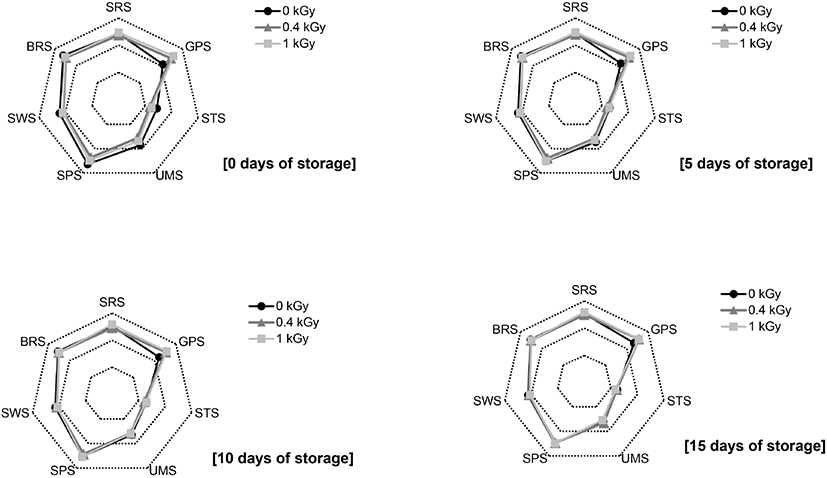
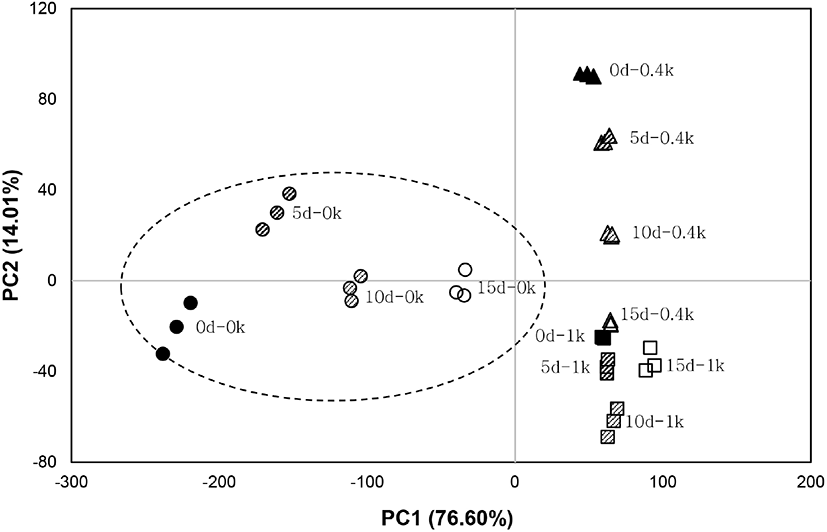
The PSL technique is known simple and quick tool for screening irradiated food without a laborious sample preparation step. Thus, PSL is considered as a rapid screening method (EN: 13751, 2002). Table 1 shows the PSL measurements and PSL ratios of the mandarin oranges irradiated with e-beam during 15 days of storage. The PCs in the PSL1 measurements were 262-445 PCs regardless of the irradiation dose. These negative results (less than 700 PCs) indicate that the sample was unlikely to be irradiated. The inaccuracy measured in PCs indicated very low sensitivity or lack of mineral quantity in the samples. Akram et al. (2012) also reported that fresh mushrooms showed low levels of PSL sensitivity, which could be attributed to the insufficient amount of minerals in the samples. Re-irradiating the samples for PSL ratio measurements of all nonirradiated samples showed PSL ratios of more than 10, which indicated their nonirradiated status. In the case of irradiated samples, PSL ratios were less than 10. From the above results, it would be unsuitable to apply the PSL method (PCs) to screen the irradiation status of mandarin oranges. Still, the PSL ratio was demonstrated to screen whether or not they had been irradiated. During the post-irradiation storage period, the irradiation status of mandarin oranges could be screened out from the nonirradiated samples by calculating PSL ratios up to 15 days of refrigeration storage irrespective of irradiation doses (Table 1), which was well proven by our previous reports on the application of PSL ratios instead of the existing PC measurements (Jo et al., 2018).
ESR is a physical method to determine the irradiation status of food items. It can detect free radicals produced during irradiation of fibrous ingredients. It has been reported that radiation-induced cellulose radicals exhibit a pair of peaks on the left and right sides based on the central signal (Delincée and Soika, 2002). Our analysis revealed that the distance between a couple of peaks is approximately 6.0 mT (Fig. 3).
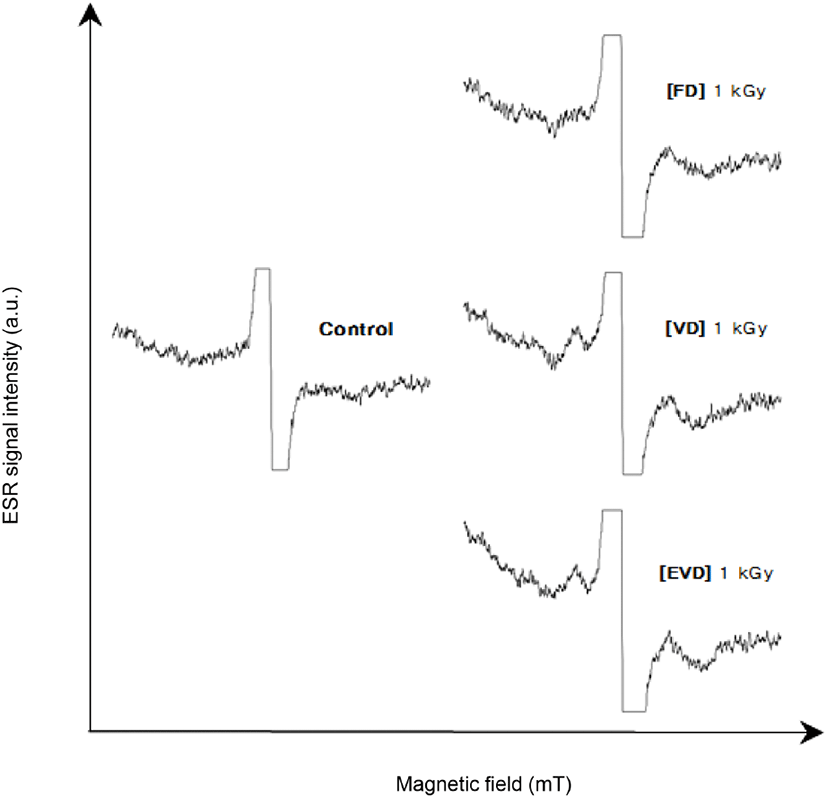
These radiation-induced radicals are vulnerable to moisture and a prolonged storage period, thereby decreasing ESR signal intensity (Yordanov and Aleksieva, 2009). The mandarin orange peel was treated using various drying methods to compare the ESR signal intensity with different drying methods. Fig. 3 compares cellulose signal intensity from 1 kGy-irradiated mandarin orange peel according to different pretreatment drying methods. The cellulose signal was clearly represented in the VD and EVD samples compared to the FD sample. The signal intensities increased with increasing irradiation dose (Fig. 4). The changes in radiation-induced signals during storage are shown in Figs. 5-7. Immediately after irradiation, cellulose signals appeared in all dried samples, despite the weak signal in the FD sample. Five days after irradiation, the VD and EVD samples showed distinct cellulose signal, whereas the FD sample did not reveal any signals. The sample treated with EVD retained a cellulose signal at all irradiation doses until 15 days of storage, but the VD did not show a radiation-induced signal at a dose of 0.4 kGy at 10 days. The VD peel of mandarin oranges showed an obvious cellulose signal compared to the FD sample. Furthermore, the addition of ethanol extraction reduced the moisture content and increased the fiber content of the samples by removing the non-fiber materials; thus, the radiation-induced cellulose signals were represented more clearly, which has also been reported for irradiated oranges (Jo et al., 2018) and dried laver (Sanyal et al., 2019) under extraction pretreatment conditions for improved detection of cellulose ESR radicals.
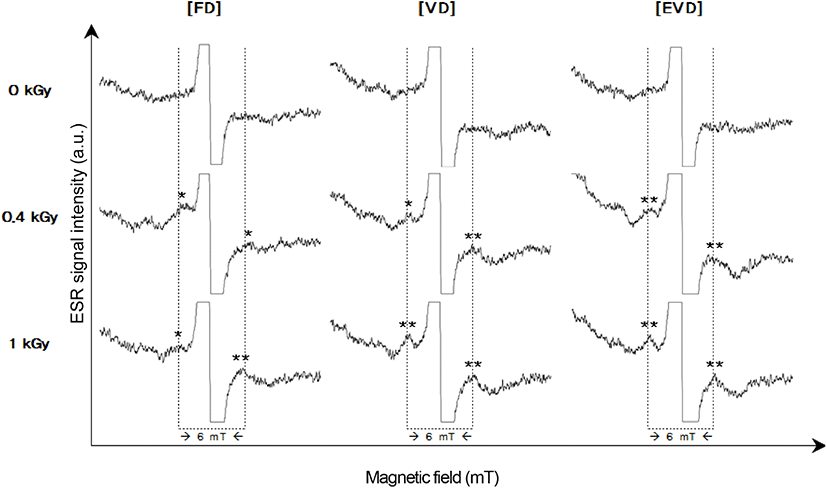
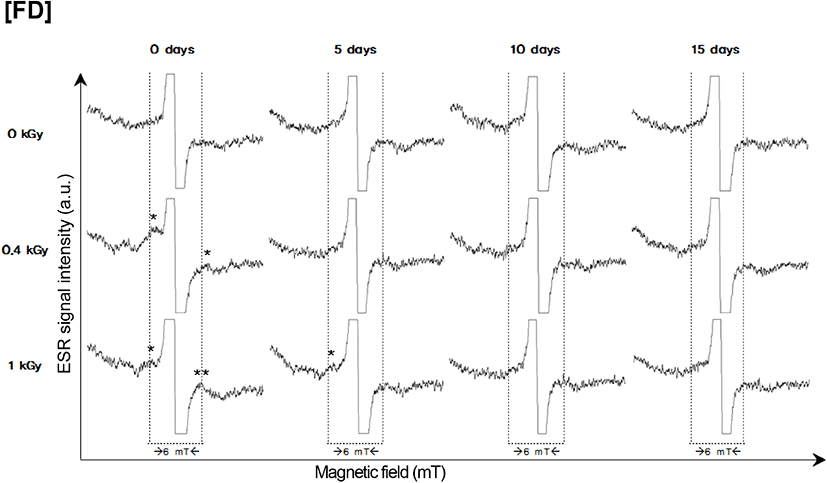
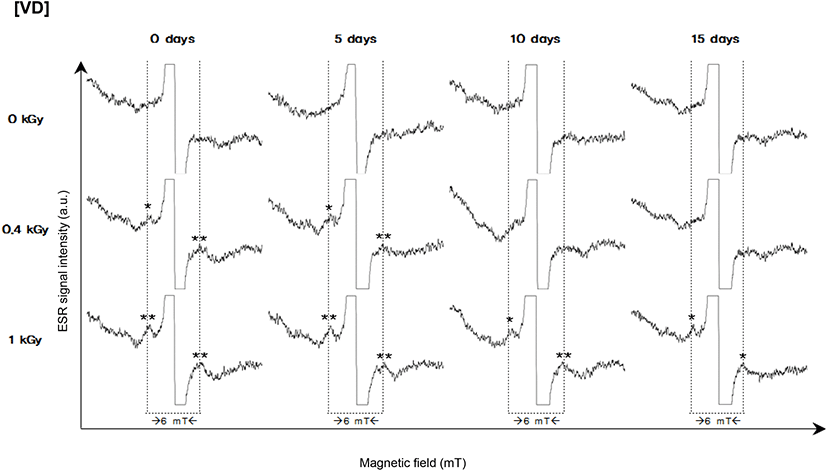
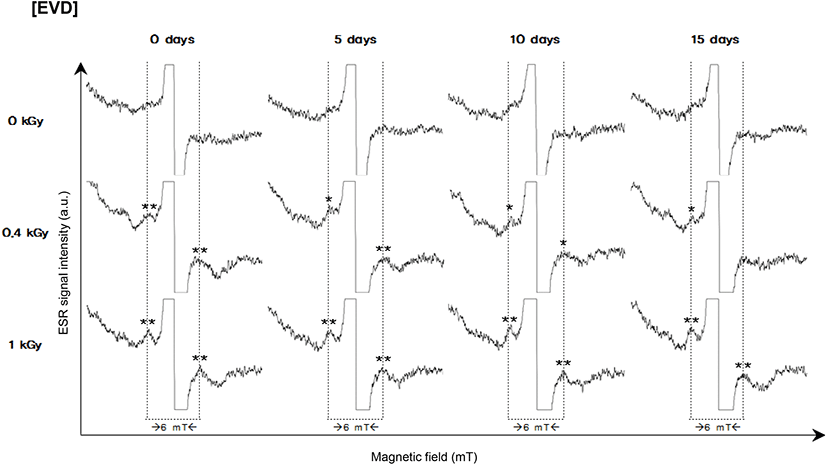
4. Conclusion
Food irradiation is an effective quarantine treatment for fresh agricultural commodities. However, reliable identification methods for irradiated products are required for import and export control (Sanyal et al., 2019). Various analytical techniques including e-tongue, PSL, and ESR were employed, confirming that e-tongue analysis potentially discriminates irradiated samples at 0.4 to 1 kGy from the nonirradiated controls until 15 days of storage at 4°C to ensure the technical and consumer acceptance of electron beam-irradiated mandarin oranges. Moreover, irradiation status could be screened by PSL ratios for 5 days and detected by ESR measurement following EVD pretreatments of irradiated orange samples at 0, 0.4, and 1 kGy during post-irradiation storage for 15 days at 4°C.
